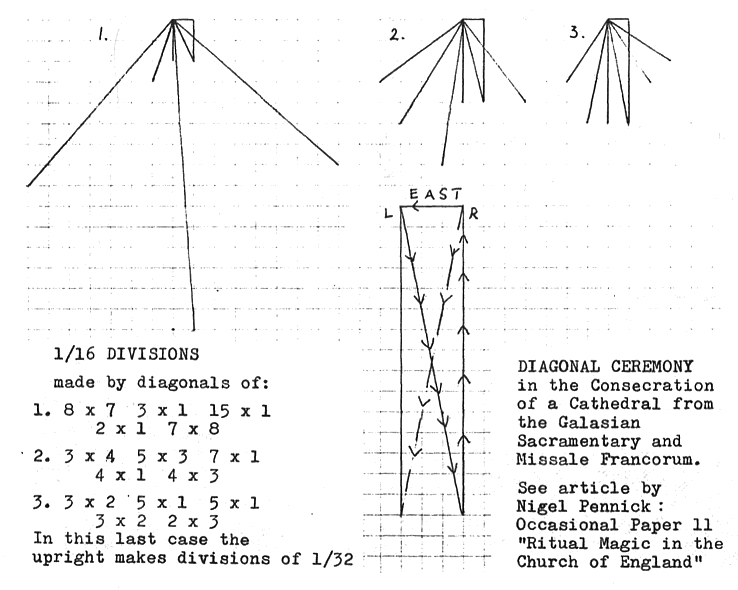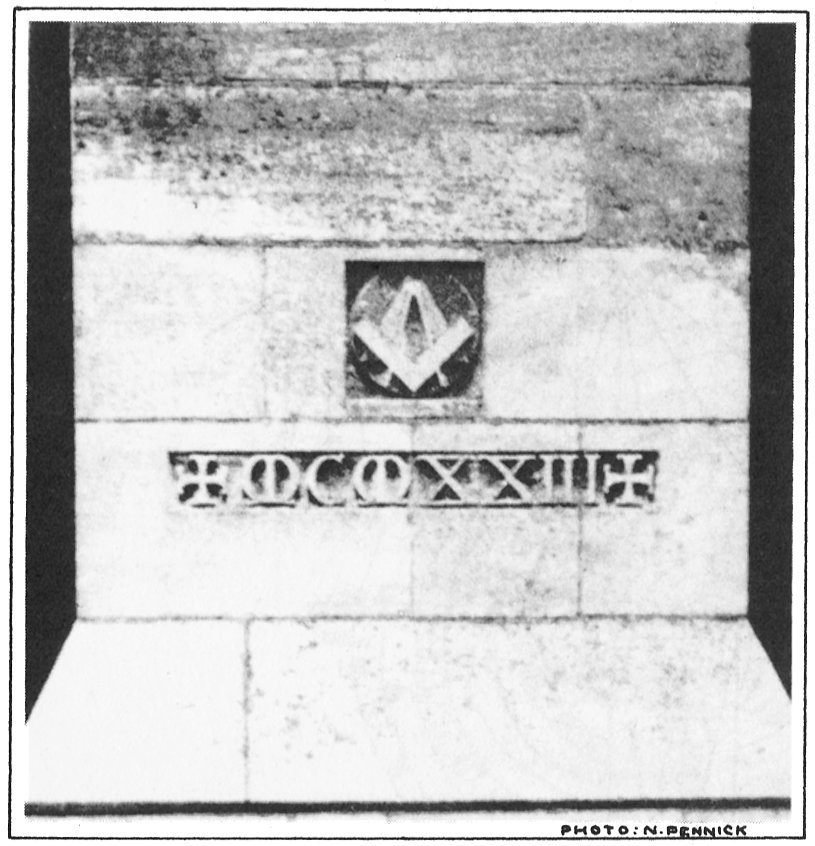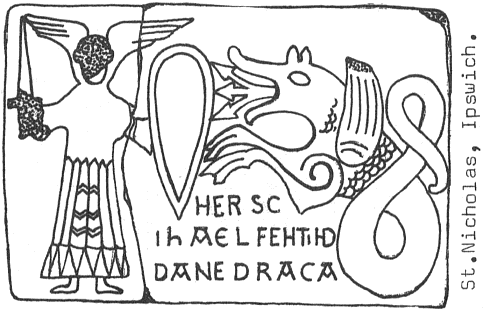
Journal of Geomancy vol. 3 no. 1, October 1978
{21}
I was most impressed by your article about Ritual Magic. The description of the early church dedication brings me into the picture as it were. What they are doing is affirming the kind of geometry I endeavour to recover. Why the Greeks and the Celtic Druids must have felt that early Christianity was so important was because it must have seemed to bear out and improve upon their own number-geometrical considerations. The later Roman Church completely crushed this element, only it returned to them with the Freemasons. To some extent it is a Dual Appreciation of life, therefore Male-Female, Yang-Yin. For the Jews and later Catholics it was to be Yang only and the Scientists took this over. Only now is science beginning to recognize its limitations and one of its limitations is the way it treats numbers.
Numbers as applied to space need all sorts of treatment to describe space at all accurately. An important factor is back-to-front numbers, 1 2 and 2 1, 12 and 21 have intimate connexions, as do 23 and 32, and both are 5 added. This is only the merest start.
The figure traced in ashes is all important. An understanding of this brings one fully into life, gives one, hopefully, a control over both sides of brain activity.
I enclose some of these figures as I envisage them (below). Their length would depend on the length of the cathedral or church. Since they operate from each side of the altar and could be supposed to have an overall connexion with a centre of a circle beyond them, the High Altar or God; they would assume the shape of the cabalistic Tree of Life. However, this Tree of Life always keeps its 6-fold implications. This is what I find deadening in cabalistic thought. For me all numbers are interchangeable, build up from 1 and 2, 2 and 1 and resolve again into these opposites. Fine to find out all the considerations of 6, very important, but we are not only bees and snowflakes, we are Roses, Starfish, Spiders, Wallflowers, Mustard Seeds as well. Then we graduate mentally to 7 and 9 to find new beginnings in 10.

{22}
I would so like to know at what angle is the compass supposed to be open in the Masonic emblem you represent from Peterborough or the emblem you have put on the back of your paper. Can one ask Freemasons such a question I wonder. Presumably not as a woman!
EDITOR’S NOTE. Below is a photograph recently taken of the Masonic emblem and the date 1923 on the buttress at Peterborough. The angle of the compasses seem to be at about 27° of arc – not 23! Research now underway on the foundation of modern Anglican cathedrals; Guildford, Coventry and Liverpool (just completed after 75 years) may show common geometrical and geomantic practices – there is certainly something ‘odd’ about the site-choosing at Guildford.

Congratulations on another IGR Journal of great excellence. Each one seems to be better than the last. Where will it all end! Indeed, all the output of the many publishing houses located at Address is of an equally high standard: the display of knowledge and learning is astonishing. Perhaps there is a research staff of dozens hidden away in a shed in the garden!
I was appalled by the photograph on the front cover (of the last JOG) of the Heel Stone at Stonehenge surrounded by barbed wire. Perhaps officialdom is afraid of the power which this stone holds! It certainly is a national disgrace however and we should campaign for its immediate removal. You were right in the editorial – the scene looks like something from the Battle of the Somme. I visited Stonehenge last in June and even then was appalled at the latest developments – the site had been roped off to all save two BBC people taking films and security goons were everywhere complete with expensive ‘snacks’ and piped muzak! Does this show how far civilization has come? These latest developments certainly make one despair for the state of our ailing so-called humanity.
{23}

Proposed English Dragon Lore Society. We hope to form an English Dragon Lore Society in the near future. The purpose of this group would be to catalogue and study English dragon legends, collect information where representations of dragons can be seen, such as churches and other buildings; to enquire into the dragon as a psychological symbol and art form; to generally study and assimilate as much information regarding the subject as we can, to look into the religious aspect and the connexion between ley lines and dragon energy.
In addition we hope to plan field trips to dragon sites, special weekend sessions for socialization and friendly discussions and to publish some sort of journal at regular intervals. If any readers of JOG are as fascinated by this ancient and famous beast as we are, perhaps they would care to contact me, expressing their interest and pass on any information they may have regarding dragons, real or imaginary, in their area.
David Adams (JOG 2/4) beat me to the punch with his comprehensive demystification of Alfred Watkins’s ley “Vision”. This evocative notion perpetrated by John Michell fitted romantically with the anti-scientific evocation leys were to be nurtured by during the sixties, but in the cause of objectivity and truth I asked Watkins’s son Allen to set the record straight (no pun intended) for the 50th issue of The Ley Hunter and this he did with his article The Moment of Discovery. Yet still what was fiction reappears in fiction when a character in The Big Fans (Fantasy and Science Fiction, No. 311, 1977, by Keith Roberts) is warning of what might happen if the ley system was reactivated. After his host has read the relevant item of corrigenda the hero remarks on cue “Good Lord”, and his host replies, “Interesting, ain’t it? And that’s not the only time it’s happened; it’s been reported by various people since.” Not only the lines like glowing wires, but the erroneous report!
A serious contender for overtaking Michell’s account as requiring frequent correction is the erroneous belief that the Elizabethan occultist Dr Dee discovered the Glastonbury Zodiac. Richard Deacon set this piece of apocrypha running and Mary Caine attempted to defuse it in Undercurrents magazine after I repeated it. John Wilcock, in writing of sites of sanctity, says Dee was “the first to point out what he described as ‘Merlin’s Secret’ ” and refers to Dee’s terrestrial zodiac map in both A Guide to Occult Britain and Magical and Mystical Sites. The words “Merlin’s Secret” in this regard appear again in the 1978 edition of Glastonbury: Ancient Avalon, New Jerusalem, edited by Anthony Roberts, where Colin Wilson’s afterword sceptically assesses the zodiac and refers to Dee’s map (though he mentions here a horse shape). At least Wilson’s depiction of Watkins’s discovery is not couched in fantastic embroidery. Then this summer the pseudonymous S.I.C. again has “Merlin’s Secret” in Coven No. 1; though I’m assured my demystification article on the topic will appear in issue 3. And on the subject of Coldharbours (JOG 2/4), it may be of interest following Lt-Col J.B.P. Karslake’s article to note that in Hartlepool, Cleveland, there was until recently a farmstead called Coldknuckles (a coldharbour variant) and opposite was the appropriately-named Traveller’s Rest public house. There is a Dead Man’s Hollow to the north-west and midway between the two is a Romano-British excavated site at Catcote (the Cat Coit Celidon of Arthurian myth?). One hundred yards or so from Dead Man’s Hollow is Summer Hill. Also it may be of interest to readers to know that in the early fifties K.H. Koop noted that places with the name Coldharbour aligned.
K.H. Koop’s article “Coldharbour alignments” appeared in Egerton Sykes’s journal Atlantis, November 1951 (pay to view at the Sykes Atlantology website). In 1945 Koop had a short letter on Coldharbour alignments in Country Life. – MB, January 2016